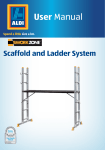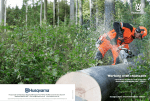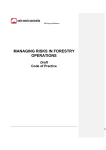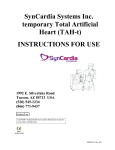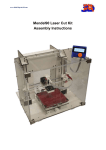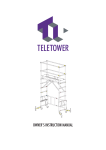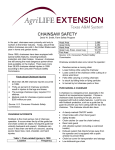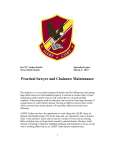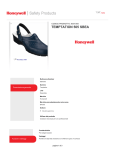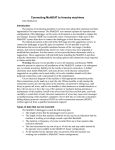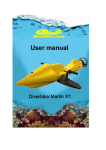Download Supplement to the booklet "Working with Chain Saw
Transcript
Supplement to the booklet "Working with Chain Saw" published by Swedish Forestry Board and which includes a summary of mandatory national regulations (AFS 2012:01) for the use of chainsaw and rules and general advice applicable in connection with the test for Säker Skogs Motorsågskörkort (Chainsaw Certificate), level A and B. By Tomas Gullberg 2013‐01‐14 Background and general information about accidents and risks In professional forestry has the chainsaw to a great extent been replaced by mechanical harvesting. However, the machine operators sometimes use chainsaws for felling oversized and odd trees or other trees that for some reason cannot be harvested by the machine. The felling of these trees can be particularly dangerous due to, for instance, steep terrain, obstacles, size, or by other reasons. In small‐scale forestry there is a large number of people who are using chainsaws, mainly small woodlot owners and contractors. Within these groups information and training on safety issues is of great importance to prevent illness and reduce the rate of accidents. Accidents with chainsaws are unfortunately too common. Annually, 5‐10 people are killed in accidents and thousands are injured. Mainly small woodlot owners are exposed but also fire wood cutters and other part time chainsaw users with little training and experience are affected. Tree felling is causing most of the serious and fatal accidents. Slipping and tripping but also cuts and injuries from the saw chain are causing the biggest numbers of accidents but usually not as serious as accidents in connection with tree felling. Investigations of the accidents show that lack of knowledge and experience in combination with lack of understanding about the risks are the main reasons for the accidents. Age‐limit for using a chainsaw Providing physical and psychological maturity and completion of vocational training with approved theoretical and practical tests (e.g. Chainsaw Certificate) you are allowed to use a chainsaw from the age of 16. If you are working alone with a chainsaw you have to be at least 18 years old. Working alone means that you cannot get immediate help in case of an accident or critical situation and that you will need some kind of communication device in order to call for help. Exemptions from the regulations for certain categories, such as private forest woodlot owners Family business owners, such as forestry woodlot owners, who works on their own premises are exempted from: the requirements for safety analysis and risk assessment including follow‐up the ban on working alone in certain types of work the requirements for work instruction and a routine for communication between workers the requirement for a separate chainsaw room the requirements for proper knowledge and training At construction work or when you are working together with other people (not family) or on others people’s property, the requirements for knowledge and training is mandatory also for self‐employed people. Safety analysis and risk assessment Safety issues at different work situations have to be assessed and all necessary measures have to be taken to prevent illness or accidents. The following shall be taken into account: the workers' theoretical and practical knowledge, the risks associated with labor hiring and temporary employment, the maintenance and service of equipment, the safety equipment, the user manual from the manufacturer (e.g. concerning safety checks and maintenance as well as approved cutting equipment), particularly hazardous work and particular safety issues when working alone. The safety analysis and implemented measures should be monitored and updated regularly. Most of the accidents during work with chainsaws occurs due to lack of knowhow and proper work technique. To reduce the number of accidents it is very important that the chainsaw operator has a good knowledge and understanding for how to use a chainsaw, about proper work technique and how to assess different felling situations and other potential risks. A kick‐back is one of the most dangerous incidents that could happens during work. The guide bar should therefore always be kept under shoulder height. A kickback could otherwise easily hit the head and neck and cause a severe injury. If acceptable light conditions cannot be arrange in the workplace, i.e. you are working during dusk and nights, further work with chainsaws should be stopped. Technical safety requirements for chain saws New chainsaws must be CE marked and adhere to the requirements in EU’s Directive for Machinery. Older, not CE marked, chainsaws must have the following protective devices (which basically are standard equipment on all new chainsaws): Chain brake, which can be released with the front hand guard by the user, or by inertia if the front hand guard is not triggered in case of a kick‐back. Front hand guard which should release the chain brake in case of a kick‐back. Chain catcher. Right hand guard at rear handle. Protective covers for the drive sprocket and flywheel. Clutch (prevents the chain to move at idle). Throttle lockout. Stop control (which should be possible to reach without moving the hands from the handles). It is also important that the de‐vibration system and the muffler are functioning. Some chainsaws could be equipped with an additional trigger that enables you to release the chain brake also from the rear handle. This safety device is recommended but not mandatory. Mandatory rules and recommendations for the use of chainsaws When there is no daylight you should either stop to work or arrange for acceptable light conditions covering the entire work area. When working indoors you should arrange for satisfactory ventilation (except for firefighters using breathing apparatus). When transporting chainsaws and fuel in vehicles, you and all passengers should be protected from fumes, explosion and fire. Anyone who works with a chainsaw should be protected from falling objects, fumes, vibration, noise, cuts etc. Safety control The chainsaw should be controlled regularly by a person with good knowledge about safety devices, use and care. Daily safety checks shall be carried out on chainsaws in use. The chain brake and front hand guard should be regularly checked by running the chainsaw at full speed and then releasing the brake by your left wrist. The chain must then stop immediately. To check the function of the inertia chain brake mechanism it is recommended to drop the tip of the guide bar against a stump. The chain brake should then be activated (note that the chainsaw should be switched off). The guide bar and the chain must also be checked for damage and wear. Chains with cracks in the links should be scrapped. Do not use accessories and cutting tools, which has not been approved by the manufacturer. Säker Skogs recommendation is to replace the chain when the shortest cutting tooth is less than 2 mm on the narrow side of the tooth upper plane (A) or 4 mm on the lateral plane's most narrow point (B), or according to the manufacturer's recommendation. The sharpening and maintenance of the chain is an important safety factor. Especially the adjustment of the depth gauge is very important to set properly in order to reduce kickbacks. Too aggressive setting of the depth gauge will increase the risk for kickbacks and make the cutting more dangerous. Always use a filing guide and follow the manufacturer’s instruction accordingly. When replacing the chain, always check for wear on the guide bar and the sprocket. Working alone When working alone with the chainsaw you should make sure that you have the ability to contact a designated person and that this person is informed about your whereabouts. People younger than 18 years old are not allowed to work alone. Working alone with chainsaw is not allowed in dangerous situations and is prohibited during the following kind of work: Cutting wind damage or fire damaged forest. Tree felling in reach of power lines. Cutting from sky lift and during tree climbing. Training requirements and knowledge By January 1, 2015 must everyone, who intends to work with a chainsaw, successfully have passed the theoretical and practical tests for the type of work they intend to carry out. They also need approved documents to certify their knowledge (e.g. motorsågskörkort or equivalent certification). Note that until the new requirements are in effect, the old rules which call for mandatory training, will be accepted as proof of sufficient knowledge. The requirements for training and certification with approved documentation do not apply to certain self‐employed people and in certain situations, such as a forest woodlot owners who works in their own premises. It is also important to maintain the knowledge and skill. If necessary, it is appropriate to repeat the training and make a new test every fifth year. Protective equipment and safety When working with a chainsaw the following personal protective equipment shall be used: Hearing protection (protective covers) Safety helmet Eye protection / visor (to protect from scrapes, flying chips and saw dust) Protective boots with steel toecap and saw guard (at least class 1) Protective trousers or chaps with protection against cuts from the saw chain (at least class 1) Work gloves Visibility clothing (CE EN 471) on the upper body. If you are working with other tasks than tree felling it is possible, after a safety analysis, to make exemptions from one or more of the requirements. When working with a chain saw, the operator shall always carry a first aid kit. Plastic safety helmets have a limited lifetime due to the exposure of sunlight, heat and different kinds of solvents. The manufacturer usually guarantees the strength for about 3 years but normally it lasts at least 5 years with proper maintenance. Protective trousers and safety boots are tested and classified in different classes based on the speed of the saw chain. Class 1, for instance, is tested to withstand a saw chain speed of 20 m/s while class 2 is tested to withstand a speed of 24 m/s without cutting through the safety padding. Safety chaps are an alternative to safety trousers and easy to put on during short time and temporary work but may give you somewhat less protection due to poor fitting. Usually they are available in only one size. It is easy to get injured during work with chainsaw due to tripping and slipping. The risks can be reduced by using boots with non‐slipping sole, by activating the chain brake and by carrying the chainsaw in the front handle (never the rear handle) when you move around, by a good stance at cutting a by keeping your work area clean, for example when you cut firewood. Always observe a safe behavior. It is important to scrap safety boots and protective trousers when the protective paddings are damaged. Note that very dirty and soiled pants may reduce the protection, try to always keep them clean. Wash and tumble dry according to the manufacturer recommendations. You may repair the outer fabric layer but never the protective material. To maintain a good safety function the threads of the protective layers must be able to move easily and grasping the saw chain in case of an accident. Always avoid to put the pants inside the safety boots or by other means constrain the protective layers. Be sure to check the hearing protectors including the sealing rings and noise absorbers. According to the Swedish Occupational and Safety Act the employer must provide safety equipment for all employees. During tree felling the operator must always organize some kind of communication with a designated person. It is important that fuel and chain oil do not cause illness or disorders for the users or the environment. It is recommended to use bio oil and bio fuel to reduce harmful emissions. Bio fuel also has better storage characteristics and can usually be stored for years. Starting the chainsaw Several starting methods are recommended. The preferred method to start the chainsaw is to position the rear handle between your legs at knee height and to pull the starter rope by your right hand. It is also recommended to have the chain brake engaged, especially when you start with the half throttle mechanism engaged. If you kick start the chainsaw “in the air" or by putting the chainsaw on the ground and then pulling the starter rope with both hands, you must always activate the chain brake. Managing the chainsaw When walking around with an idling chainsaw, always carry it in the front handle in order to reduce the risk of accidental throttle opening, for example if you are slipping. Make sure to activate the chain brake if you walk some distance with an idling chainsaw (recommended behavior but not required). Do never walk around with a running saw chain. Cutting should not be done above shoulder height due to the danger of a kickback hitting the face. It is not allowed to hold the chainsaw in one hand and cut. All cutting should be done with a good stance and, if possible, by holding the chainsaw close to your body. Always avoid the danger to get a kick‐back by avoiding to cut with the “kickback sector” (the upper part on the top of the guide bar). Begin to cut by using high chain speed, a firm grip on the handles and smooth movement. By cutting with the underside of the guide bar (pulling saw chain) you get the best control. Cutting firewood Place the wood in a fixed position or rather use a work bench when you cut firewood. Avoid cutting on the ground or directly in the stack of logs in order to avoid rolling logs and the danger of tripping, pinching the saw chain and kick‐backs. Tree felling The work should be planned so that it can be done in a safe way and the work crew should be instructed how the work should be carried out. During tree felling close to buildings, recreational areas and in other areas with people, it is important to put up warning signs at all access roads. Normally is the safety distance for tree felling one tree length. Only the feller is allowed to work within the reach of the tree. The felling shall be stopped if someone else enters the area. If necessary, due to difficult trees or for other particular reasons and after a safety analysis, more than one person may work within the reach of the tree. During chainsaw training and education you may also be exempted from this rule. Before you begin to fell a tree you must have planned and cleaned an escape route. This will enables you to put yourself in a safer position when the tree falls. All felling should be done in such a way that the last cut, before the tree falls, is made from the safest position. If two or more chainsaw operators are working with tree felling in a logging site, it is important that they can work independently, in their own areas, without getting too close to each other. Note that the safety distance always is more than double the tree length when two or more operators are working. When the logging comes to the end, the risk increases that the safety distance will not be kept. Then, to avoid felling accidents, it is important to organize the work properly to avoid dangerous situations. Safety distance, more than double the length of the tree. Always keep your felling tools available during the felling. The most common felling tools are felling lever, wedges, tree pushers and winch. You are not allowed to bring a tree in tension by a winch or a machine before the felling cut is made. If you, for instance, use a harvester to push the tree, make sure the felling cut is finished and that the chainsaw operator has pulled out from the danger zone before the harvester position itself and begins to push down the tree. About felling tools Different felling tools are designed for various methods. Very small trees can easily be pushed over by hand. A simple pushing rod is suitable for small and tall trees, preferably with some kind of spike in the top of the rod to get a firm grip on the tree. Tree pushers are rather common and are much more powerful than just a pushing rod. Make sure that the tree pusher has a firm support on the ground and is fixed firmly in the tree before you start to push. Felling tools, which are inserted into the felling cut, such as felling levers and wedges, provides greater leverage the bigger the tree is. It is therefore important not to make a too deep directional cut. Felling levers are available in different sizes and with different length on the lifting bar. With a long lifting bar you get a better leverage and are able to push over heavier trees. On big trees wedges provides a lot of felling power and especially if you put two or more side by side and use a heavy hammer to force them into the felling cut. Actually, several wedges are more powerful than a tree pusher on big trees. Big trees, leaning backwards, may require different types of wedges and with different gradient. Professional tree fellers should then have at least three wedges on hand to be able to handle difficult and backward leaning trees. The most powerful and safest felling method for big and difficult trees is, however, to use a winch or to pull them down with a tractor. Make sure the anchor point is attached rather high on the tree and that nobody is in the danger zone when you start to pull. The felling hinge The basis for controlled and safe felling with precision is a proper felling hinge (strong and flexible). The hinge shall be of sufficient length and correct thickness. As a general rule of thumb the length should be at least 80% of the tree’s diameter at breast height and the thickness of about 10% of the tree’s diameter at breast height. For trees bigger than 30 cm it is usually enough to leave a three cm thick hinge. The felling cut should normally be cut in line with the notch. Many trees have buttresses which may cause tilted wood fibers in the felling cut and the hinge. If the felling cut is put above the notch on trees with buttresses, there is a significant danger of a weaker or even non‐existent hinge and thereby uncontrolled felling. A too thick hinge makes the felling heavy and less accurate since the hinge tends to break off instead of bending. The force it takes to bend the hinge increases with the square of the thickness. This means, for instance, that a 4 cm thick hinge is about 4 times as heavy to bend compare to a 2 cm thick hinge. It is also important that the hinge is even in thickness to obtain precise felling. A very thin hinge pose a danger since it might not hold and the tree could the fall uncontrollably at any direction. Rotten trees or trees with other defects in the wood are dangerous to fell and should preferably be felled in their natural lean. Frozen wood is harder and more brittle resulting in a weaker hinge. To enable the hinge to control and guide the fall of the tree, the angle of the notch should be quite open. As a rule of thumb, on flat ground, the open angle of the notch should be about 75 degrees. Then the hinge will break off just before the tree hits the ground. Note that the opening angle should be adapted to the terrain and any obstacles to prevent splitting. If the felling cut is not made correctly and for instance the hinge has been damaged or weakened by rot root, a new notch and felling cut could be done by cutting higher on the stem, more than one meter above the first cut. Note that you should then always try to fell the tree in the direction of its natural lean. Note that during the practical test you are usually not allowed to make a second attempt by making a new felling cut. Hang‐up trees Lots of serious and fatal accidents are associated with hang‐up trees. Therefore, be careful when you choose where to fell the tree and observe extreme caution when there is a situation with a hang‐up tree. Hang‐up trees which are leaning with small inclination are usually rather safe and easy to bring down by rolling with the help of a cant hook or turning strap. Note that a piece of the hinge should be left at the same side as the tree will be rolled. More difficult hang‐ups must usually be pulled backwards. Sometimes it may require a winch or tractor. A hang‐up tree should be brought down as soon as possible. If you have to leave a hang‐up or partly cut tree, for example to get help and proper felling tools, the danger area shall be marked with marking tape or similar. Do never stay in the danger area. It is also strictly forbidden to fell the supporting tree and to fell another tree on the hang‐ups. Your supervisor shall always be notified when a hang‐up tree cannot be brought down in a safe manner with your standard felling tools or when it for other reasons is subject to danger situations. When you are felling trees in steep terrain there is a risk that the trees will roll or slide down the slope. During tree felling close to buildings, power lines, walking trails and roads, always take additional precautions. Make sure to secure the tree with wedges and winch and use guards that can alert passing people. When felling trees near power lines the owner of the power line shall always be contacted before the work begins. Storm damage forest, fire damaged forests and particularly dangerous trees To cut and clear storm damaged and fire damaged forests with chainsaws are very dangerous and cause a lot of accidents. Try to primarily use harvesters, winch systems or similar methods in the first place. If you work with storm damaged or fire damaged trees or by felling of particularly difficult trees, the work must be organized in such a way that the chainsaw operator always stay in contact with his work colleagues. You are not allowed to climb leaning trees and by working on top of wood piles. Trees which are in tension should always be cut with proper technique to avoid splitting and dangerous situations. When there are big piles of up‐rooted trees, then the trees shall be pulled apart with a tractor or winch before you start to cross‐cut and snag them. When a harvester and a chainsaw operator are working together in the same area and at the same time, a written instructions and functioning two‐way communication must be in place. When felling trees in fire damaged forest you must be aware of the risk that many trees might have weakened and damaged roots and may fall down very suddenly. Using chainsaws from a platform, e.g. skylift To use a chainsaw at higher levels than the ground should only be made from the floor of a building, from a working platform, scaffold or if you have personal fall protection equipment. All work from skylift or by climbing requires special training and knowledge about the risks, both in cutting technique, climbing technique and how to handle the lift. When starting the chainsaw in the skylift the chain brake must always be activated. It is important that the platform (skylift) is set up and operated according to the instructions. When working with chainsaws from a platform, it is important to establish certain safety instructions, for example, if more than one operator has to work from the same platform. Tree pruning It is important that all people who are pruning trees with chainsaws and by climbing (using climbing tools, ropes and safety harnesses) have sufficient knowledge about the work and about the risks associated with work. Note that it is forbidden to work with chainsaws from ladders without safety harness with fall protection. Also be aware that big branches might swing and hit you or hit the ladder when they bounce on the ground. Power lines When you are felling and cutting trees close to power lines, always contact the owner before the work begins. When a tree is leaning towards the power line or is hanging into the power line, the power must be turned off by the owner of the power line before the work begins. Felling tools such as winches, wedges and other equipment necessary for the work shall be available and if necessary used to force the trees or parts of trees to fall in the desired direction. When tree felling and cutting by chainsaw close to power lines has to be done at night, acceptable light conditions must be arranged at the work place. If the conditions due to storm damage, snow damage or other reasons are considered to be very dangerous, other methods should be used to clean the power lines. During exceptional circumstances, when the use of chainsaws are considered to be too dangerous, harvesters or other machines should be used and if the area is accessible by the machines. As an alternative you could also use explosives (blasting clamps), pole saws or so called “tossing saws”. Note that if you use explosives you need a license.














